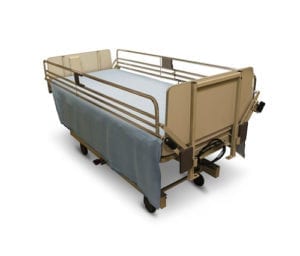Bedrails are often standard on nursing home beds — which are essentially hospital beds that have been adapted for use in the nursing home.

Every year, there are thousands of elderly residents of nursing facilities that are injured because of an unsafe bedrail situation. Many die from suffocation because the bed rail has restricted their breathing.
According to the Consumer Product Safety Commission and the US FDA, bed rails can be dangerous. Even so, there are few rules and regulations available to keep elderly patients from suffering injuries due to bed rails in hospitals and nursing facilities.
Statistics On The Misuse Of Bed Rails
Here are some important statistics about bed rails used in nursing home facilities:
- More than 50 percent of the bed rail accidents reported to the FDA have resulted in the death of the patient.
- There are about 5 million nursing home beds and hospital beds in use in the United States.
- About 4,000 elderly residents are treated in emergency departments for bed rail injuries every year.
- There have been approximately 550 deaths among nursing home residents reported since 1995 due to bed rails.
According to government agencies, many nursing facilities do not report injuries and deaths related to bed rails. This means that the statistics and numbers that we have regarding bed rail injuries probably underestimate the true scope of the problem.
Why Are Bed Rails Used in Nursing Facilities?
Bed rails are often metal rails that normally hang on the side of the patient’s bed. They are used in nursing facilities for a variety of reasons, including:
- Fall prevention. They can keep a resident from getting out of bed or rolling off the bed during their sleep, causing injury to themselves.
- Additional support. The bed rails can also act as a support mechanism for patients who are trying to adjust their bodies in bed. The rails can help them to get in and out of the bed on their own.
For patients who are not usually disoriented and who have some physical strength to make use of a bed rail, these bed rails are relatively safe, convenient and easy to use.
How Are Bed Rails Dangerous To Nursing Home Residents?
The most common method by which nursing home residents are injured by bed rails happens when they become lodged between the mattress of their bed and the bed rail itself.
Nursing facility residents are often frailer and much more likely to be on sedating medication than most other elderly persons. When these individuals fall into the space between the mattress and the bed rail, they sometimes lack the strength and coordination to move their bodies out of the gap.
It is their body weight that causes them to sink further into the space between the mattress and the rails. Their chest cavity becomes pushed upon and they lose the ability to breathe. Death is usually caused by cardiac arrest or asphyxiation, as they become increasingly stressed in their breathing and remain trapped, unable to get out.
Other bed rail injuries can occur when the patient becomes disoriented and confused and tries to crawl over the bed rails and off the side of the bed. When they fall out of the bed at this height, it can cause the resident to sustain painful fractures and other types of injuries.
What Makes Bed Rails So Unsafe To The Elderly?
The major reason why bed rails are considered to be so dangerous is that they do not have significant rules and regulations to make sure that they are safe for all types of patients. Bed rail injuries and deaths have been reported to government agencies for the last thirty years; however, safety warnings and guidelines for the manufacturing of bed rails have not yet been put in place by the manufacturers.
Another reason behind the danger in bed rails is that they are not always used with the right mattresses and beds. Bed rails are designed to be safe when used in many cases. If you use a bed rail with the bed frame for which it was designed and a mattress that was designed for the bed, there is little risk in using the bed rail.
The problem with bed rails is that as nursing homes move beds around, disassemble beds and reassemble beds, they are often mixed with the wrong bed and the wrong mattress. The two products are used together even when there is not a perfect fit between them. This can create a dangerous gap between the bed rails and the mattresses that can create an environment where accidents are likely to occur.
Preventing Bedrail Injuries
When you are visiting your family member or loved one at a nursing facility, you should always check the bed and the bed rails to make sure that they fit properly and are safe to use.
Push the mattress as far away from the bed rails as you can. If you are able to stick four fingers or more between the bed rails and the mattresses, then the bed should be considered unsafe. When buying bed rails for use at home, it is important to research what you are buying, as they do not always match the mattresses that they are sold along with.

